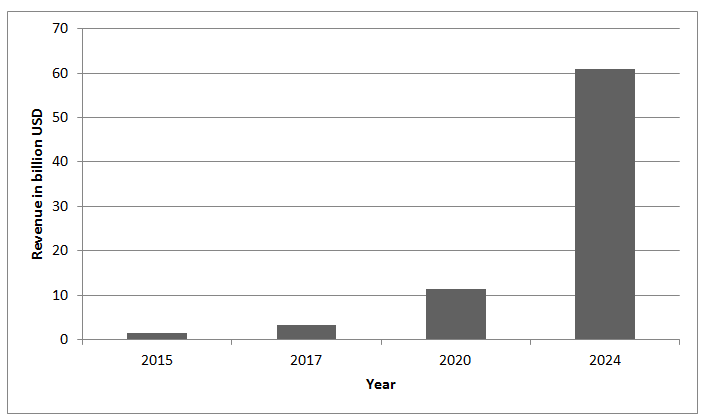Virtual Reality Market is expected to reach USD 86.27 billion by 2024 with CAGR of 51.7%.While AR/MR market is expected to reach USD 130 billion by 2022
July, 2019 | Source: Profshare Market Research
Virtual Reality (VR) is the use of computer technology to create a simulated environment. Unlike traditional user interfaces, VR places the user inside an experience. Instead of viewing a screen in front of them, users are immersed and able to interact with 3D worlds. By simulating as many senses as possible, such as vision, hearing, touch, even smell, the computer is transformed into a gatekeeper to this artificial world. The only limits to near-real VR experiences are the availability of content and cheap computing power.
Augmented Reality (AR), the computer uses sensors and algorithms to determine the position and orientation of a camera. AR technology then renders the 3D graphics as they would appear from the viewpoint of the camera, superimposing the computer-generated images over a user’s view of the real world.Hearing is arguably more relevant than vision to a person’s sense of space and human beings react more quickly to audio cues than to visual cues. In order create truly immersive Virtual Reality experiences, accurate environmental sounds and spatial characteristics are a must. These lend a powerful sense of presence to a virtual world. To experience the binaural audio details that go into a Virtual Reality experience, put on some headphones and tinker with this audio infographic.
Further key findings from the report suggest:
The semi and fully immersive segment dominated the Global Virtual Reality Market in 2016 in terms of the overall market share. Immersive VR devices aid users to achieve maximum isolation from the real world dimension into the virtual world.
The GTD VR hardware includes sensors, processors, and displays. Furthermore, several companies are working on enhancing the quality of sensors and processors used in VR devices.
In the entertainment and healthcare segments, VR applications can save time and reduce operational costs.
The North American region dominated the marketplace, accounting for the largest Global Virtual Reality Market share (in terms of revenue) in 2016.
The key industry participants include CyberGlove Systems LLC, Barco, Alphabet Inc., HTC Corporation, Oculus VR LLC, and Leap Motion, Inc.

VR/AR/MR is projected to be a US$150bn market by 2020-22E, with VR accounting for 1/4 (US$30-34bn) and AR/MR for 3/4 (US$90-117bn)
VR Application Outlook (Revenue, USD Million; 2018 - 2025)
• Aerospace & Defense • Commercial • Consumer Electronics • Industrial • Medical
VR Device Outlook (Revenue, USD Million; 2018 - 2025)
• Head-Mounted Display (HMD) • Gesture Tracking Devices (GTD) • Projectors & Display Walls (PDW)
The VR Head Mount Devices (HMD) technology offers a cost-effective and reliable solution to experience immersive virtual experience by means of a smartphone. The consumer electronics application segment would dominate the sector in terms of market size over the forecast period. The growing adoption of medical and consumer electronics based VR applications is anticipated to revolutionize the market by 2025.
Connect With Us
- International : +1-917-795-8886
- Asia-Pacific :+91-8623077278
- Email: [email protected]
Market Research Industries
Why Profshare?
High Data Accuracy
Precise research methodology, numerous analysis models & up to date data resources to achive most accurate market values.
Customization as Needed
We can tailored the report as per your requirments & budget, Most of our clients prefer custom reports.
Budget Friendly Solution
We have quality market data for all types of budget & so now get best out of your market research budget.
Quality Support
Be assured of receving satisfactory analyst support to understand research report in-detail.
